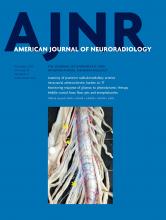We appreciate the comments from Drs Lim and Moon on our article entitled, “Dynamic Contrast-Enhanced MRI Reveals Unique Blood-Brain Barrier Permeability Characteristics in the Hippocampus in the Normal Brain,” and appreciate the opportunity to respond.
The first comment is focused on the permeability model used in dynamic contrast-enhanced (DCE)-MR imaging postprocessing. In our study, we used a commercially available software, Olea Sphere (Olea Medical, La Ciotat, France), using the extended Tofts permeability model to postprocess the acquired DCE-MR imaging data into blood-brain barrier permeability (BBBP) parameters of Ktrans and VE. The authors suggest the use of the Patlak model combined with long scan times of 10–30 minutes1 to improve the contrast-to-noise ratio for Ktrans, thereby improving the detectability of subtle BBB permeability changes.
Different theoretic models have been proposed for DCE-MR imaging data analysis, including the Tofts and extended Tofts models, the adiabatic tissue homogeneity model, the 2CX model, the distributed capillary adiabatic tissue homogeneity model, and the gamma capillary transit time model.2 The model used in our study, while less robust as indicated by the authors, is readily integrated in the clinical setting and is thus more practical from a clinical standpoint compared with the other aforementioned models. The Tofts model and other models have previously been shown to overestimate Ktrans, and variability in Ktrans values across different models is a known issue affecting all models.2,3 Most important, even if absolute Ktrans values may have been overestimated in our study, all subjects were analyzed with the same model conditions; therefore, our conclusions regarding relative region-based changes in Ktrans remain valid.
While there are certain inherent disadvantages to the Tofts and Kermode model in detecting subtle BBBP changes, our study nevertheless revealed statistically significant region-specific BBBP differences in healthy subjects. Most important, the purpose of our study was to compare the BBBP in different brain regions in healthy subjects and not to optimize permeability models or parameters. We used a commonly used commercial software and found statistically significant results on an intraindividual level.
Although we mentioned in our Materials and Methods section that 80 cine phases were performed, we did not explicitly state that the acquisition time was 11 minutes 14 seconds. The benefits of extending the acquisition time in clinical practice may be limited by considerations such as patient tolerability, cost, and renal clearance of gadolinium-based contrast agents.4 The authors additionally requested details of the acquisition protocol based on a consensus recommendation on BBB permeability imaging in small-vessel disease.4 Given that our findings are specific to young healthy volunteers without small-vessel disease, we did not consider that the referenced consensus guideline applied in this study; however, in our Materials and Methods section, we do state specific pertinent DCE-MR imaging acquisition parameters. Our aim was to apply DCE-MR imaging protocol and postprocessing methods, which can be readily implemented into clinical workflows.
We would next like to address the authors’ comments on spatial resolution and section thickness and concerns regarding contamination of the hippocampal measurements by the hippocampal artery and choroid plexus. We acknowledge that caution must be exercised when interpreting our results, given the small sample size in our study and the challenge in avoiding choroid plexus contamination in the ROI sampling of the hippocampus, and we mention these important points in the limitations section of our article. We would also like to emphasize that we used rigorous methods when placing the ROIs in the hippocampal region using trained research personnel closely supervised by an experienced neuroradiologist. Our research team has >15 years’ experience in performing these methods of ROI placement in the brain while minimizing contamination from other structures (such as vascular structures, choroid plexus, ventricles, CSF, and skull) in our prior publications. As visualized in Fig 1, meticulous care was taken to minimize the possibility of choroid plexus contamination when placing the hippocampal ROI. As an added precaution, ROIs with CBF values >100 mL/100 g/min were excluded from the statistical analysis to further avoid possible contamination of the data from any vascular input, particularly the choroid plexus. Our findings were consistent across subjects, as evidenced by the individual-subject DCE curves supporting our data being robust using these methods. Furthermore, our data are also concordant with other previously published animal model data,5 and DCE-MR imaging–based human studies demonstrating increased hippocampal BBB permeability,6 providing additional support from the literature.
We do not have personal experience with the nordicICE software (NordicNeuroLab, Bergen, Norway) mentioned by the authors; however, we use the Olea software on a daily basis in a clinical setting at both the first and senior authors’ institutions (Weill Cornell Medical College and Northwell Health, respectively). Typical Ktrans values in normal-appearing brain parenchyma using our clinical acquisition and analysis protocol (with Olea software) are approximately 0.01, with slightly higher values typically seen in the hippocampus, concordant with the findings in our study.
We would like to clarify that the measurement unit for Ktrans (milliliters/minute/100 mg) is mathematically equivalent to the units mentioned by the authors (minute−1 × 10−2) because milligrams and milliliters are equivalent, assuming a density of 1 kg/m3. The 10−2 factor (and variability of inclusion thereof in different perfusion-analysis software packages) may have contributed to the difference between nordicICE and Olea data observed by the authors and to the difference pointed out by the authors regarding published studies.6
We agree with the authors that precise methodology in BBB permeability imaging is extremely important. We recognize that our study reveals initial proof-of-concept findings that warrant further investigation. As we stated in our Conclusions, “This work may help further our understanding of specific brain regions susceptible to neurologic diseases affecting the BBB. Larger scale prospective studies evaluating hippocampal BBBP characteristics are needed to confirm these findings and potentially incorporate them into diagnostic and therapeutic strategies.”
We appreciate the authors’ interest in our study and hope our reply clarifies their questions.
Thank you.
References
- © 2019 by American Journal of Neuroradiology












